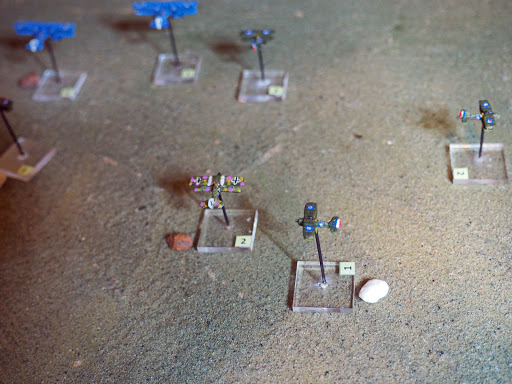We watched a couple of episodes of the 1976 BBC TV series 'Wings' last night, which is a drama about members of the RFC in 1915/16. So far we've just had the recruitment and training episodes, but they had a boxkite, BE2 and Avro 504 on screen, and they were all lovely. As I recall some of the later flying sequences were done with radio-controlled models where they couldn't get actual aircraft; no CGI in those days, kids. Anyway, we might watch a few more episodes and see how it goes; it's OK in a plodding BBC Sunday evening drama kind of way.
Afterwards I still found time to play a game of 'Spandau and Lewis'. This time I got ot the bombers; a trio of Friedrichshafen G.IIIs, escorted by a couple of Halberstadt CLII two-seaters.
In the distance you can see the Camels moving around to intercept the bombers.
The SE5s concentrated their fire on the lead bomber.
I used a 'rolling road' board for this game. When a plane exited off the target edge I moved everything back half a board, and did this twice to essentially double the length of the table. If anything was displaced off the back I counted them as having left the table and diced for their return on subsequent moves.
The changes to how observer guns fire worked quite well, with fire from the bombers less deadly than it's been in the past. A plane can risk a pass, but if they hang around too many bombers for any length of time then small accumulated hits will be a problem. The bombers are a pretty static target though. If a plane can get on their tail, it's hard to shake it off, so using the escorts effectively is essential (or bringing in support fire from other bombers). I assumed that the bombers were on a deadline, though, so they didn't manoeuvre that much; some of my issues may simply be scenario design ones.















No comments:
Post a Comment